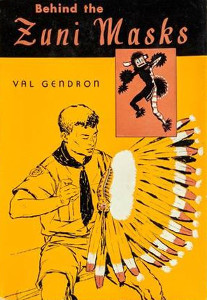Behind the Zuni Masks

Author:
Val Gendron
Publication:
1958 by Longmans, Green and Co., Inc.
Simultaneously published by:
The Junior Literary Guild
Genre:
Fiction
Pages:
214
Current state:
Basic information has been added for this book.
It is under consideration and will be updated when it is evaluated further.
Book Guide
Search for this book used on:
When Charlie Nickerson, Boy Scout and confirmed Yankee from Cape Cod, came to La Junta, Colorado, where his family was to live, he believed he was leaving behind him everything that made life interesting and exciting. he meets Buck, the leader of the Boy Scout Troop. He discovers the Kiva, or Indian House, of the Koshare Scout Troop, and a whole new world opened up to him—the world of Indian lore and handicrafts and dances. Koshares, he found, were Explorer Scouts whose project was to make known and appreciated the culture of the southwest Indians throughout the country. They put on shows which were of professional caliber, using the money they so earned to develop their Kiva and perfect their skill. Charlie becomes an ardent participant and finally, after his election to the Troop as a brave, one of the outstanding performers in the shows and a teacher of the Indian dances to the other Scouts. In their enthusiasm and quite unaware of offense, the boys prevail upon their sponsor to let them dance the beautiful Shalako of the Zunis. This lands them in a heap of trouble, for the Zunis protest, resenting this use of their sacred dance as a show. In a stirring climax there is a meeting between the Koshares and the Zuni representatives and restitution is made to the Indians.
Authentic, the unique background and the steady well-paced narrative presents an exciting plot. The boys in the story are real, they ring true, and there is the fine climax of the test of Charlie and his friends pending election to the Kosahre Troop. This unusual and absorbing tale, with a dramatic final outcome, gives good Americana, and a narrative most boys will find engrossing.
From the dust jacket
To view an example page please sign in.
Find This Book
Search for this book used on:


